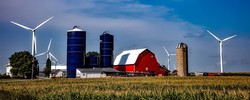It’s not just what U.S. farmland is foreign-held, it’s what’s the intentions are
by Brian Boyce
American farmers might want to get to know their neighbors a little better in coming days if they’re interested in leasing land from foreign investors.
A new online tool created by the Midwest Center for Investigative Reporting allows individuals to check up on just how much American land is currently owned by foreign entities, and the results might be surprising. Between 2004 and 2014, these databases show foreign investors doubled their American farmland holdings, growing from 13.7 million to 27.3 million acres, which is approximately the size of Tennessee. And while this represents only about 2 percent of total U.S. farmland, the value of the land in question leapt from $17.4 billion to $42.7 billion during the same period, according to U.S. Department of Agriculture data.
Concerns about the growing amount of control foreign countries have on American farmland, and in turn American food prices, has prompted a bi-partisan bill introduced to the U.S. Senate by Sen. Debbie Stabenow (D-Michigan) and Sen. Chuck Grassley (R-Iowa) titled the Food Security is National Security Act of 2017, which “amends the Defense Production Act of 1950 to: (1) require the Committee on Foreign Investment in the United States to consider the potential effects of a proposed or pending transaction on the security of the U.S. food and agriculture systems, including the effects on the availability of, access to, or safety and quality of food; and (2) include the Secretary of Agriculture and the Secretary of Health and Human Services as members of the committee.”
“As we think about the future and the growing global population, it’s important to consider who will control the food supply. Today, there may not be a food shortage in the world, only distribution problems that are more the result of politics and not logistics, but in the decades to come, it may be a different story,” Grassley stated in a media release on the topic.
It’s not just a concern about who owns what, but rather what their intentions are. Many of the farm properties currently owned by foreigners are slated for wind farms rather than grain farming — concern about foreign control of grain supplies date back many years, and during the 1970s governors from numerous states facing the same issue drove Congress to pass the Agricultural Foreign Investment Disclosure Act (AFIDA) in 1978, which governs reporting requirements of foreign investors. Changes in food supply directly impact price, and those concerns came back to life though in 2013 when Chinese firm Shuanghui purchased U.S. pork producer Smithfield Foods and, along with it, more than 146,000 acres of farmland. Shuanghui paid $4.7 billion for the company, a price most in the U.S. felt represented a 30 percent premium. Why, if not for future pricing control over American food, they asked aloud.
Who owns what?
The Midwest Center for Investigative Reporting tool allows individuals to search by county, state, or name in a variety of manners. A broad overview reveals that Canada is among the largest foreign owners of U.S. ground, and foreign ownership ranges broadly from state to state. Nearly 13.2 percent of Maine is foreign-owned, compared to only 4.8 percent of Alabama, but when combined, this translates into a Vermont-sized section of Maine and a Deleware-sized section of Alabama. Canada’s 6.87 million acres makes it the top foreign owner, followed by the Netherlands with 4.87 million acres, Germany with 1.94 million acres, the United Kingdom with 1.7 million acres, Italy with 1.4 million acres, Portugal with 1.38 million acres, and France with 1.04 million acres. About 54.9 percent of the U.S. land under foreign ownership is forestland, followed by 23.6 percent pastureland and 21.5 percent cropland.
The amount of foreign-owned land totaled 10 million acres in 1998, 19.8 million acres in 2008 and then 27.3 million acres in 2014. The total amount of forestland went from 3.4 million in 1998 to 5.3 million acres in 1999, then to 10.6 million acres by 2006. More than 290,000 acres valued at $336 million do not list an owner, and nearly 1 million acres do not list what country their owners are from, this land being valued at $1.4 billion.
And why do they own it?
Reasons for foreign investors to buy American ground vary with the investor. In the case of Maine’s largest private landowner, Canadian timer company Irving Woodlands, their use for their 1.2 million acres is pretty clear. Approximately 8.8 percent of Hawaii is also foreign-owned, with most of those acres going for cattle pasture. But in terms of the Netherlands, a nation with only 16 million citizens that still comes in as America’s No. 3 foreign investor, the answer is simply cold cash.
Stephen Raes, economic minister for the Netherlands embassy in Washington, D.C., explained in an article in USA Today that the Dutch nationalized pension system is about 130 percent the size of that nation’s gross domestic product, thus making it the world’s largest relative to the size of its economy. That pension plan favors conservative investments, such as American farmland, he said, adding that historically Dutch immigrants to the U.S. became Midwest farmers all throughout the 19th century.
Just how much sway will American farmers have over foreign owners remains to be seen, and while all seems quite friendly for now, the sudden change has many concerned. But for younger Americans seeking entry into the business of farming, these moves should be taken into consideration. Historically, leasing land to farm is one of many entries into farming, and in coming years, the changes of leasing American farm ground from a foreign nation might be higher than the multifloral rose climbing their fences.













